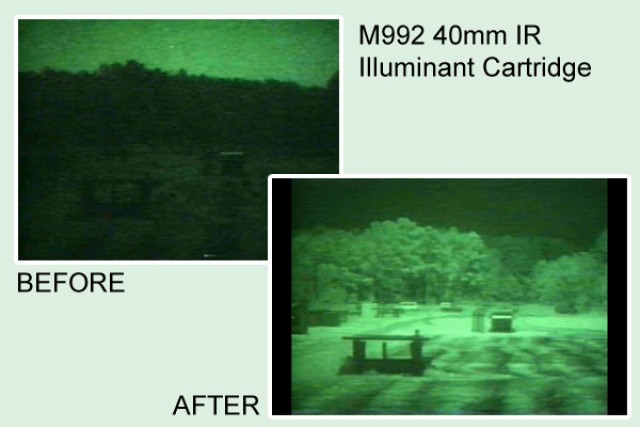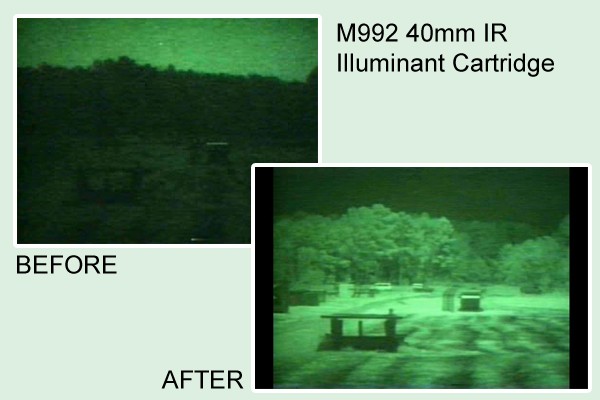PICATINNY ARSENAL, N.J. -- Soldiers now have capabilities to engage the enemy far more effectively during nighttime operations, following the recent full materiel release of three infrared illuminating rounds.
The term full materiel release signifies that the Army has rigorously tested and evaluated the item and determined it is completely safe, operationally suitable and logistically supportable for use by Soldiers.
The M1064 105mm Infrared Illuminating Cartridge; the M1066 155mm Infrared Illuminating Projectile; and the M992 40mm Infrared Illuminant Cartridge were approved for full materiel release via the Program Executive Office for Ammunition (PEO Ammo), headquartered at Picatinny.
"PEO Ammo manages and oversees the acquisition and lifecycle of all conventional ammunition for U.S. warfighters," said Brig. Gen. Jonathan Maddux, Picatinny Senior Commander and the Program Executive Officer for Ammunition. "Products like infrared illuminating cartridges and projectiles are just a few examples of how we strive to be leaders in providing the best conventional, leap-ahead munitions that bring new and more effective capabilities to our joint warfighters."
Illuminating cartridges, or pyrotechnic flares, have been widely used by militaries for years, but they have previously only provided light in the visible spectrum, which the enemy can utilize as well. The Army's new infrared illuminating cartridges/projectiles produce infrared light that is invisible to the naked eye, but is clearly visible through night vision devices which U.S. Soldiers use in Iraq and Afghanistan.
Following the full materiel release of these three additional munitions, the Army now has visible light and infrared capability for all calibers of mortars, artillery and 40mm.
The IR illuminating munitions were developed at Picatinny Arsenal by the Armament Research, Development and Engineering Center (ARDEC), which developed and fielded the world's first-ever IR illuminating munitions in 2002 (the 60mm M766, 81mm M816 and 120mm M983 Infrared Mortar Illuminating Cartridges).
"IR illumination burns longer, significantly increases the area of battlefield illumination and its performance is less sensitive to temperature and firing conditions compared to the standard visible light illumination," said James L. Wejsa, Chief of ARDEC's Pyrotechnic Technology and Prototyping Division, which led the pyrotechnic formulation, design and qualification testing of the candle assembly for these mortar and artillery IR illuminating munitions.
M1064 105MM INFRARED (IR) ILLUMINATING CARTRIDGE
Approved for full materiel release on Dec. 9, 2010, the M1064 provides enhanced covert capability over the current 105mm, M314A3 Illuminating Cartridge (visible light) due to the candles' faint visible signature while descending in the air.
Fired from an M119 series howitzer, the IR illumination capability of the M1064 greatly improves visibility in tactical operations against enemy targets during periods of darkness when using Night Vision Devices.
Ground coverage of IR illumination provides over 2.5 times the diameter of visible light illumination, which enables friendly forces using the M1064 greater fields of view to better assess targets and engage the enemy.
"IR illumination increases mobility during night operations, allowing the commander to shape tactical engagements, mass effects and support maneuverability from disparate locations and lessen over reliance on direct fires," said William Vogt, Project Officer for Mortars and Artillery Illumination, Project Manager Combat Ammunition Systems (PM-CAS), the PEO Ammo group that manages the M1064.
Additionally, the M1064 utilizes the M314A3 firing solutions, as the M3143 allows a mission to use both capabilities - infrared light and visible light - without firing adjustments.
The Army has 8,300 in inventory and plans to procure an additional 5,500 by the end of fiscal year 2011. This will follow with approximately 3,000 cartridges every other year. The M1064IR Cartridge is slightly higher in cost than the M314A3, but it provides a new capability unlike the M314A3.
M1066 155MM INFRARED (IR) ILLUMINATING PROJECTILE
Approved for full materiel release on Oct. 14, 2010, the M1066 IR illumination artillery projectile provides approximately 120 seconds of IR illumination. This round provides enhanced covert capability over the current 155mm M485 Visible Light projectile and greatly improves visibility in tactical operations against enemy targets during periods of darkness when using Night Vision Devices.
In addition to the visibility enhancement, IR Illumination provides a covert capability due to its faint visible signature while in the air. Ground coverage of IR illumination provides over two times the diameter of illumination when compared to the M485A2 visible light illuminating projectile currently in U.S. inventory.
The M1066 can be fired from a 155mm howitzer system like the M109, M777, and M198 howitzers. It is fired with the M762A1 electronic time fuze and could be fired with the M119A2, M231, M232A1 propelling charge.
Like the M1064, the M1066 also provides warfighters the opportunity to use both infrared and visible light.
Also managed by PM-CAS, the Army plans to procure 7,000 M1066 rounds in fiscal year 2010, and 4,000 every other year. The U.S. Marine Corps plans on procuring 8,000 in fiscal year 2011 and approximately 4,000 every other year. The cost of the projectile is approximately the same as the visible light projectile.
M992 40MM INFRARED (IR) ILLUMINANT CARTRIDGE
Approved for full materiel release on Oct. 8, 2010, the M992 provides an illumination/signaling capability via an infrared candle - a first of its kind for the M203 and M320 40mm grenade launchers. The round can also be fired from the legacy M79 40mm grenade launcher.
"The M992 provides a capability not previously available to the Soldier that takes advantage of U.S. Armed Forces technology to improve night-time operation success," said Gregory Bubniak, Project Officer for 40mm Ammunition, Project Manager Maneuver Ammunition Systems (PM-MAS). "It enhances night operation capabilities of troops equipped with night vision equipment, while producing minimal visual signature outside of the infrared spectrum. This will allow users to access the approximately 90,000 cartridges available in inventory. "
Managed by PM-MAS, the Army plans to field approximately 22,000 M992 cartridges in 2011.
The M992 is approximately 50 percent more costly than visible light spectrum cartridges fired from the M203 and M320 (such as the M583A1, M661 and M662) due to small quantities purchased. However, increased quantities would decrease cartridge cost significantly, Bubniak said.
"The product cost is justified by the M992 capability when compared to limited alternative IR device options currently available to the user," he said.




Social Sharing